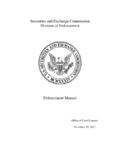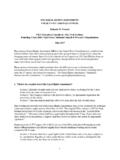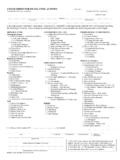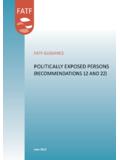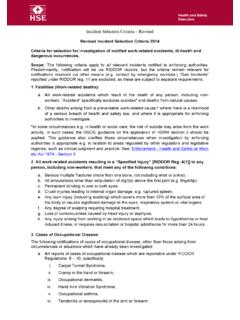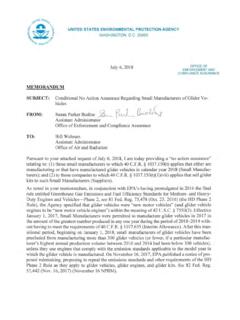Transcription of Enforcement Management Model (EMM)
1 Enforcement Management Model (EMM) Operational version Contents Enforcement Management Model (EMM) Summary What is the EMM? What is the EMM used for? When is the EMM used? Limitations of the EMM Review arrangements EMM overview Purpose of Enforcement Process of Enforcement Purpose of the EMM EMM in detail Step 1: Enforcement priorities Priorities for action Health and safety risks Permissioning Non risk-based compliance and administrative arrangements Step 2: Risk of serious injury Assess the actual risk of serious injury Dealing with serious risk Step 3: Gap analysis Principles Determining the risk gap: Actual risk Determining the risk gap: Benchmarking Determining the risk gap: Defining risks and benchmarks Determining the risk gap: Health risks Risk tables Permissioning Non-risk based compliance Step 4: Initial Enforcement expectation Principles Standards and benchmarks Determining the initial Enforcement expectation Prosecution Prosecution of individuals Formal cautions Health and safety risks Compliance and administrative arrangements Permissioning Amended to accommodate changes in RIDDOR October 2013 Step 5: Dutyholder factors Principles Dutyholder factors Step 6: Strategic factors Public interest Process Review of action Step 7.
2 Enforcement conclusion Targets for action Timescales Concluding factors Amended to accommodate changes in RIDDOR October 2013 Enforcement Management Model Summary What is the EMM? 1 The Enforcement Management Model (EMM) is a logical system that helps inspectors to make Enforcement decisions in line with the Health and Safety Executive s (HSE s) Enforcement Policy Statement (EPS). The EPS sets out the principles inspectors should apply when determining what Enforcement action to take in response to breaches of health and safety legislation. Fundamental to this is the principle that Enforcement action should be proportional to the health and safety risks and the seriousness of the breach. What is the EMM used for?
3 2 The EMM: provides inspectors with a framework for making consistent Enforcement decisions; helps managers monitor the fairness and consistency of inspectors Enforcement decisions in line with HSE s policy; and assists less experienced inspectors in making Enforcement decisions. 3 It can also assist others (eg those directly affected) in their understanding of the principles inspectors follow when deciding on a particular course of action. When is the EMM used? 4 Inspectors apply the principles of the EMM in all of their regulatory actions. Enforcing authorities may develop procedures that specify the circumstances in which inspectors will formally use the EMM. 5 Inspectors Enforcement decisions are also sampled and reviewed using the EMM as part of routine monitoring. This, together with the uses described above, promotes increased consistency and fairness in Enforcement . Limitations of the EMM 6 Inspectors are confronted by a myriad of unique variables when carrying out inspections, assessments and investigations, including different work activities, sectors, organisational structures, contractual relationships etc.
4 Assessing risk and compliance with the law therefore ranges from being relatively straightforward to extremely complex. Amended to accommodate changes in RIDDOR October 2013 7 The EMM is a straightforward linear Model and so cannot truly capture all the nuances and complexities of discretionary decision making in all circumstances. While the EMM provides a framework for driving consistency, it is crucial that inspectors discretion is not fettered by artificially constraining all decisions to the EMM. 8 The EMM is therefore supported by a review process that requires inspectors and line managers to consider whether the proposed Enforcement action meets HSE s EPS, the Code for Crown Prosecutors in England and Wales (CPS Code) and the Prosecutors Code in Scotland.
5 Occasionally, the review may reach an alternative Enforcement conclusion. When this occurs, Inspectors will record the final decision and the reasons. (All references to the CPS Code throughout this document should be read as including the Prosecutors Code in Scotland.) Review arrangements 9 The EMM will be kept under review and revised as necessary. EMM overview Purpose of Enforcement 10 HSE believes in firm but fair Enforcement of health and safety legislation. The purpose of Enforcement is to: ensure that dutyholders take action to immediately deal with serious risks; promote and achieve sustained compliance; and ensure that dutyholders, who breach health and safety requirements, and directors and managers who fail in their responsibilities, may be held to account. This may include bringing the alleged offenders before the courts in England and Wales, or recommending prosecution in Scotland, in the circumstances set out in HSE s EPS. Process of Enforcement 11 Inspectors use various Enforcement techniques to deal with risks and secure compliance with the law, ranging from the provision of advice to Enforcement notices.
6 They can also initiate or recommend prosecution where the circumstances warrant punitive action. Making decisions about appropriate Enforcement is fundamental to the role of an inspector. Crown bodies are exempt from statutory Enforcement but HSE can issue non-statutory improvement and prohibition notices, and censure Crown bodies in Amended to accommodate changes in RIDDOR October 2013 circumstances where, but for Crown immunity, prosecution would have been justified. 12 The process of making Enforcement decisions is complex. Each dutyholder is unique, and inspectors must have a thorough understanding of the hazards and control measures associated with each dutyholder s activities.
7 It is vital that inspectors have wide discretion to exercise their professional judgement so that action, appropriate to each situation, can be taken. Further guidance may be found in the Treasury Solicitor s document, The Judge Over Your Shoulder ( ). 13 Enforcement decisions must be impartial, justified and procedurally correct. HSE s EPS sets out the approach that enforcing authorities should follow. Enforcement action must also be taken in accordance with the aims of the Enforcement Concordat of the Better Regulation Executive part of the Department for Business Innovation and Skills. As public regulators, HSE and local authorities (LAs) are accountable for managing the Enforcement process. 14 The EMM provides HSE and LAs with a framework for making Enforcement decisions that meet the principles in the EPS. It captures the issues inspectors consider when exercising their professional judgement and reflects the process by which Enforcement decisions are reached. Purpose of the EMM 15 The EMM is not a procedure in its own right.
8 It is not intended to fetter inspectors discretion when making Enforcement decisions and it does not direct Enforcement in any particular case. It is intended to: promote Enforcement consistency by confirming the parameters, and the relationships between the many variables, in the Enforcement decision-making process; promote proportionality and targeting by confirming the risk-based criteria against which decisions are made; be a framework for making Enforcement decisions transparent, and for ensuring that those who make decisions are accountable for them; help experienced inspectors assess their decisions in complex cases; allow peer review of Enforcement action; and guide less experienced and trainee inspectors in making Enforcement decisions. 16 The EMM and its associated procedures aides review of the decision-making process and inspectors Enforcement actions to ensure the purpose and expectations of the EPS have been met. Amended to accommodate changes in RIDDOR October 2013 17 The EMM does not exist in isolation.
9 It is supported by quality procedures which address, among other things, the selection and investigation of accidents. Its application also relies on guidance that provides inspectors with yardsticks with which to promote consistent use of the EMM. EMM in detail 18 Figure 1 provides an overview of the EMM and refers to a detailed explanation of each element. Amended to accommodate changes in RIDDOR October 2013 Determine risk gap (Step 3) Health and safety risks Permissioning Priorities for action (Step1) Is there risk of serious personal injury? (Step 2) Compliance and administrative arrangements Identify initial Enforcement expectation (Step4) Apply dutyholder factors (Step 5) Apply strategic factors (Step 6) Enforcement conclusion (Step 7) No Yes Consider action using HSW Act section 22 and/or section 25 Once Ss 22/25 action concluded, reconsider the overall situation and apply the EMM to any remaining Enforcement issues (see para s 33 & 34) Figure 1 Process of the EMM Amended to accommodate changes in RIDDOR October 2013 Step 1.
10 Enforcement priorities Priorities for action 19 While intervention priorities are guided by HSE s Strategy, and LA-specific programmes, inspectors have discretion in deciding the priorities for Enforcement action. 20 During regulatory contacts, inspectors collect information about hazards and control measures. From this, they make judgements about the health and safety risks associated with the activity under consideration. Inspectors should prioritise specific hazards and consider common root/underlying causes to ensure they deal immediately with serious risks. They should consider how best to achieve sustained compliance with the law and whether any punitive action is required. 21 The priorities for action may involve a single issue or several issues, eg in the case of workplace transport where driver training, the segregation of pedestrians and vehicles, lighting, maintenance etc might be issues. When applying the EMM to a particular case, it is important to bear in mind all issues that make up the priority for action to ensure the right ones are assessed at the risk gap stage and the correct standards are used etc.










